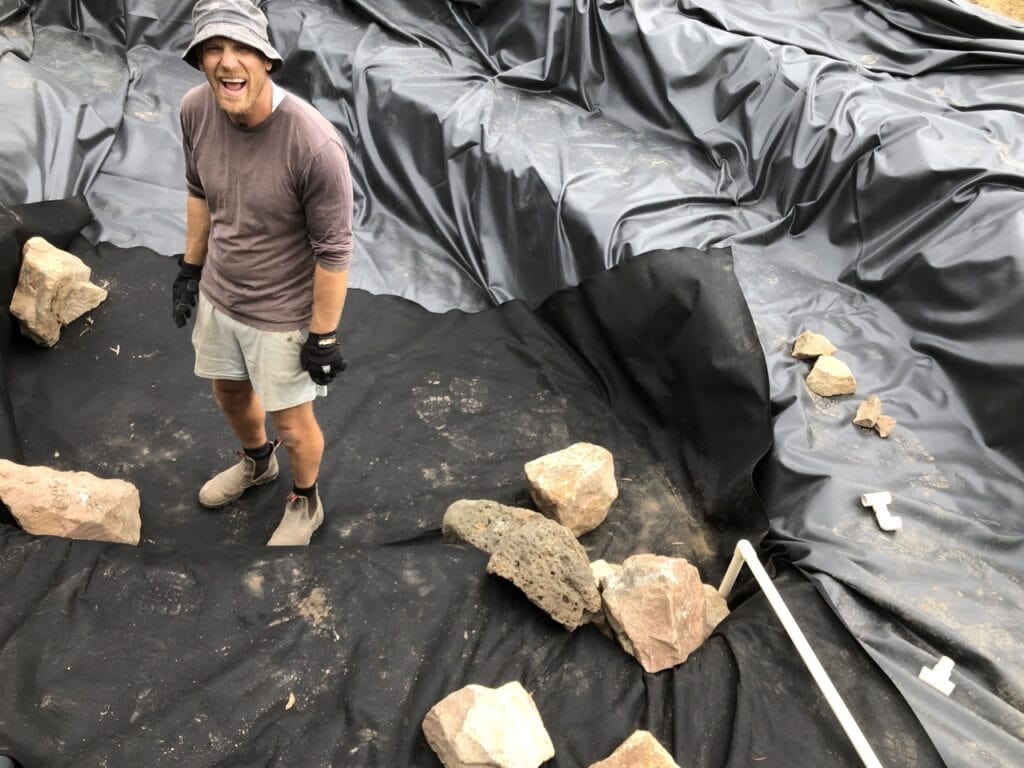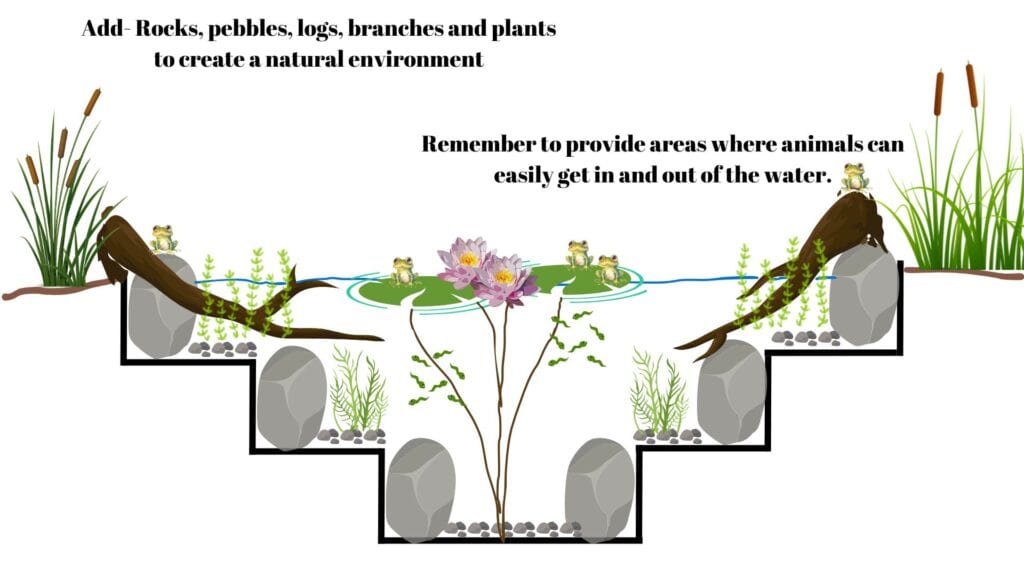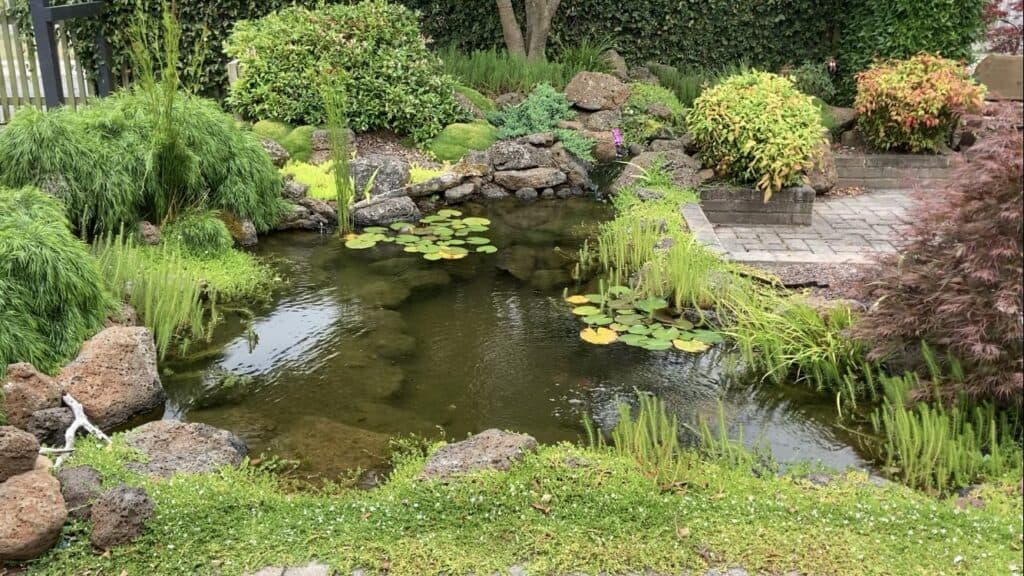A natural pond can bring joy to your backyard, attracting wildlife and creating a peaceful oasis.
The good news? You don’t need heavy machinery to build one! Whether you want a small frog pond or a larger fish pond, a well-planned pond will be easy to maintain and look fantastic for years to come.
Planning Your Pond
The first step to building a pond is choosing the right location. Ideally, your pond should be visible from your house so you can enjoy the view even when indoors.
If that’s not possible, place it near an outdoor area where you like to spend time, such as a patio or veranda.
Consider the natural slope of your land. If you want a waterfall or stream, a gentle slope will help. The shape and size of your pond also matter—if you want it to look natural, avoid straight edges.
Keep in mind that adding rocks, logs, and plants will slightly reduce the final pond size, so dig a little bigger than you think you need.
Think about depth. A small frog pond might only be 30 cm (1 foot) deep, while a fish pond should be at least 60 cm (2 feet) deep.
Larger fish will need more water volume and depth. If you live in a cold climate, ensure your pond is deep enough that it won’t freeze solid in winter.
What about excess soil? Instead of getting rid of it, use it to enhance your pond’s surroundings! Soil can help divert excess rainwater away from the pond (preventing water quality issues) and assist in landscaping around the edges.
Filtration: The Key to a Healthy Pond
A common mistake people make is digging a hole, lining it, filling it with water, adding fish and plants—then wondering why it turns green or smelly. Proper filtration makes maintenance easier and keeps the water clear and healthy.
There are ponds that function without filtration, but for most people, some form of water movement and filtration is essential. Water movement helps capture waste, leaves, and debris, reducing maintenance and improving water quality.
A basic filtration system consists of:
- A Skimmer or Intake Bay: This is where your pump sits, drawing in water over a shallow zone. It helps collect floating debris like leaves and dust before they sink and decompose. It also prevents the pump from clogging or sucking in small pond life like baby fish or tadpoles.
- A Biological Filter: This houses beneficial bacteria that break down fish waste. My personal favourite is a bog filter, which is simple, effective, and blends beautifully into a natural pond.
Building the Filtration System
The pump should sit inside the skimmer or intake bay, pulling water from the pond. That water is then pumped into the biological filter, which should be positioned above the water level so the filtered water can flow back into the pond using gravity.
If you want a waterfall, position the biological filter higher up to allow for a natural cascade.
For the best results, place the inflow on the opposite side of the pond from the pump. This ensures a steady flow of clean water and helps reduce maintenance.
Choosing the Right Pump & Filter Size
Your pump size depends on:
- Pond volume
- Fish population
- Type of filtration system
- Whether you want a waterfall or stream
If you’re unsure, I have a free bog filter sizing calculator, to help determine the right pump and filter size for your setup.
If you plan on creating streams and waterfalls you might want to use my cheat sheet formulas download.

Blueprint I use to build my ponds
- All the numbers I use to design my ponds, delivered straight to your inbox
- These formulas have helped people all over the world build beautiful, low maintenance ponds, without spending a fortune.
- Access to a private community of like minded people and a chat bot that loves answering pond related questions.
Digging Your Pond
Once you’ve planned everything, it’s time to dig! You can dig a medium-sized pond by hand.
For example, my courtyard pond that’s 3m x 4m (13ft x 10ft) and 60cm (2ft) deep was dug by hand dug in around 5 hours. If you want a large pond, you might consider hiring a digger.
Lining the Pond: To keep the water in, use a pond liner. I recommend EPDM rubber, but LLDPE is a cheaper alternative. You can use the above link to check out both options.
Making It Look Natural
To hide the liner and create a natural appearance, use:
- Large rocks on vertical edges
- Pebbles and gravel on flatter sections
- Aquatic plants to blend the pond into the landscape
- Logs and branches to create natural habitats for wildlife
As you dig, make sure to leave space for rock positioning, as adding rocks and plants will reduce the final pond size.

This video shows how I dug, built and constructed the filters for my courtyard pond.
Final Thoughts
Building a natural pond without heavy machinery is entirely possible and incredibly rewarding. By planning properly, choosing the right depth, and setting up effective filtration, you’ll have a beautiful, low-maintenance pond that enhances your yard and attracts local wildlife.
If you’d like a detailed cheat sheet, including:
- How to size your pump and filter
- How much liner, rock, and gravel you’ll need
- Plumbing sizes
- Links to build videos
- Links to design videos
You can purchase that here.

Join my free email list
If you would like to join my free email list click the button below.
I promise I won’t spam you, I’ll only send information I think can help you save money building and maintaining a pond.

